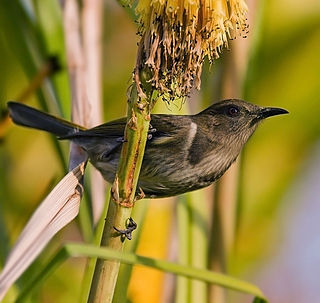
The honeyeaters are a large and diverse family, Meliphagidae, of small to medium-sized birds. The family includes the Australian chats, myzomelas, friarbirds, wattlebirds, miners and melidectes. They are most common in Australia and New Guinea, and found also in New Zealand, the Pacific islands as far east as Samoa and Tonga, and the islands to the north and west of New Guinea known as Wallacea. Bali, on the other side of the Wallace Line, has a single species.

Lichenostomus is a genus of honeyeaters endemic to Australia.

The striped honeyeater is a passerine bird of the honeyeater family, Meliphagidae, found in Australia. It is a medium-sized honeyeater, about 23 cm (9.1 in) in length. Both sexes are a light greyish brown with dark brown centres to the feathers, which give the appearance of stripes. The stripes are particularly distinct on the head and back of the neck. While it is found mainly in inland eastern Australia where it inhabits the drier open forest, it is also found in coastal swamp forest from southeast Queensland to the central coast of New South Wales.

The banded honeyeater is a species of honeyeater in the family Meliphagidae with a characteristic narrow black band across its white underparts. It is endemic to tropical northern Australia.

The bridled honeyeater is a species of bird in the family Meliphagidae with distinctive rein-like markings on its face that is endemic to northeastern Queensland. It is found in subtropical or tropical moist upland forests and subtropical or tropical rainforests, usually above 300 meters. In winter, it descends to lower forests including mangroves, and can sometimes be seen in more open habitats.

The grey-headed honeyeater is a species of bird in the family Meliphagidae. It is endemic to Australia.

Lichmera is a genus of bird in the honeyeater family Meliphagidae.

Melidectes is a genus of bird in the honeyeater family Meliphagidae. All six species are endemic to New Guinea. The generic name is derived from the Greek meli for honey and dektes for beggar or receiver.

The sooty honeyeater is a species of bird in the family Meliphagidae. It is found in the New Guinea Highlands. Its natural habitat is subtropical or tropical moist montane forest.
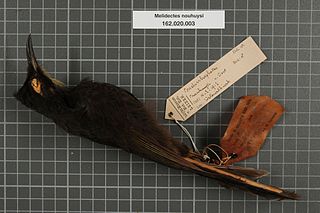
The short-bearded honeyeater is a species of bird in the honeyeater family Meliphagidae. It is found mainly in West Papua. Its natural habitat is subtropical or tropical moist montane forests.
The long-bearded honeyeater, is a bird in the honeyeater family Meliphagidae.
Gilliard's honeyeater or the Bismarck honeyeater, is a bird species in the family Meliphagidae. It is the only species placed in the genus Vosea. It is endemic to New Britain. Its natural habitat is subtropical or tropical moist montane forests.
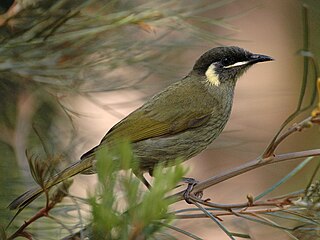
Meliphaga is a genus of birds in the honeyeater family Meliphagidae.
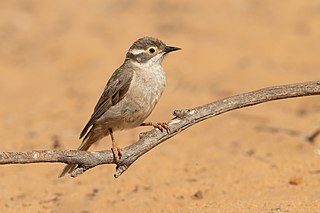
The brown-headed honeyeater is a species of passerine bird in the family Meliphagidae. It is endemic to Australia. Its natural habitats are temperate forests and Mediterranean-type shrubby vegetation.
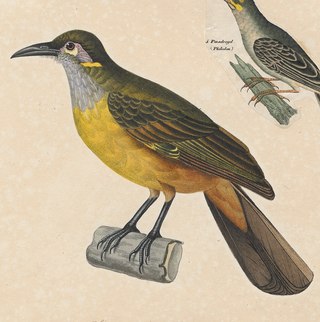
The tawny-breasted honeyeater is a species of bird in the family Meliphagidae. It is found in Australia, Indonesia, and Papua New Guinea. Its natural habitats are subtropical or tropical moist lowland forests, subtropical or tropical mangrove forests, and subtropical or tropical moist montane forests.

The spotted honeyeater is a species of bird in the family Meliphagidae.

The Kadavu honeyeater is a species of bird in the family Meliphagidae. It is the only species placed in the genus Meliphacator. It is endemic to the islands of Kadavu in Fiji. Its natural habitats are subtropical or tropical moist lowland forests and tropical mangrove forests.

Ptilotula is a genus of honeyeater consisting of species occurring in Australia and Papua New Guinea. The genus consists of six former members of Lichenostomus, and was created after a molecular analysis showed the genus was polyphyletic. The International Ornithologists' Union accepted this change and officially included the genus in reference lists from 2013. The type species is the yellow-tinted honeyeater. Birds in this genus typically occupy dry open forest and woodland habitats, and can be found in arid and semi-arid environments.

Microptilotis is a genus of birds in the honeyeater family Meliphagidae.
Melionyx is a genus of bird in the family Meliphagidae.

















